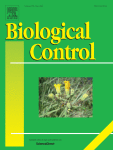Ver ítem
- xmlui.general.dspace_homeCentros Regionales y EEAsCentro Regional Santa FeEEA ReconquistaArtículos científicosxmlui.ArtifactBrowser.ItemViewer.trail
- Inicio
- Centros Regionales y EEAs
- Centro Regional Santa Fe
- EEA Reconquista
- Artículos científicos
- Ver ítem
Microorganisms as biocontrol agents against bacterial citrus diseases
Resumen
Citrus represents one of the most widely grown crops on the planet, extensively cultivated for both the fresh fruit and juice markets. The productivity of citrus orchards can be seriously affected by highly aggressive pathogenic bacteria, such as Xanthomonas citri subsp. citri, Xylella fastidiosa subsp. pauca and currently Candidatus Liberibacter asiaticus. Different microbiological biocontrol agents have been described against these pathogens, such as
[ver mas...]
Citrus represents one of the most widely grown crops on the planet, extensively cultivated for both the fresh fruit and juice markets. The productivity of citrus orchards can be seriously affected by highly aggressive pathogenic bacteria, such as Xanthomonas citri subsp. citri, Xylella fastidiosa subsp. pauca and currently Candidatus Liberibacter asiaticus. Different microbiological biocontrol agents have been described against these pathogens, such as antagonistic bacteria (mainly species from Pseudomonas and Bacillus genus) and bacteriophages. This review summarizes all the microbiological control strategies reported so far against bacterial diseases that affect citrus, highlighting those fields of study where there is great potential yet to be discovered.
[Cerrar]

Autor
Poveda, Jorge;
Roeschlin, Roxana Andrea;
Marano, María Rosa;
Favaro, María Alejandra;
Fuente
Biological Control 158 : 104602 (July 2021)
Fecha
2021-07
Editorial
Elsevier
ISSN
1049-9644
Formato
pdf
Tipo de documento
artículo
Palabras Claves
Derechos de acceso
Embargado
 Excepto donde se diga explicitamente, este item se publica bajo la siguiente descripción: Creative Commons Attribution-NonCommercial-ShareAlike 2.5 Unported (CC BY-NC-SA 2.5)
Excepto donde se diga explicitamente, este item se publica bajo la siguiente descripción: Creative Commons Attribution-NonCommercial-ShareAlike 2.5 Unported (CC BY-NC-SA 2.5)
Metadatos
Mostrar el registro completo del ítemÍtems relacionados
Mostrando ítems relacionados por Título, autor o materia.
-
Manejo de malezas en el cultivo de pecán
Taiariol, Dario (EEA Bella Vista, INTA, 2022-12-15)Una planta no deseada en un lugar no deseado. No siempre invasivas o salvajes. Efectos adversos de malezas. -En plantas jóvenes: Compite y afecta la disponibilidad de nutrientes, luz y agua y, además, alelopatías. - En ... -
Taladrillo de los forestales: algunos aspectos de su biología, detección y manejo de poblaciones
Cichon, Liliana; Garrido, Silvina Alejandra; Lago, Jonatan; Ahmad, Samir (EEA Alto Valle, INTA, 2013)Megaplatypus sulcatus Chapius, conocido vulgarmente como "barreno" o "taladrillo de los forestales", es un coleóptero que produce severos daños en plantaciones forestales y frutales perforando el tronco de los árboles, ... -
Revalorización del Complejo de Depredadores Polífagos Asociado al Cultivo de los Cítricos, Como Agentes de Control Biológico de Plagas Claves
Bouvet, Juan Pedro (Departamento de Producción Vegetal, Universitat Politècnica de València, 2018-12)Dentro de los enemigos naturales de plagas en los agroecosistemas, los depredadores han sido considerados como uno de los grupos de mayor importancia. Sin embargo, su compleja biología y comportamiento ha obstaculizado en ...

